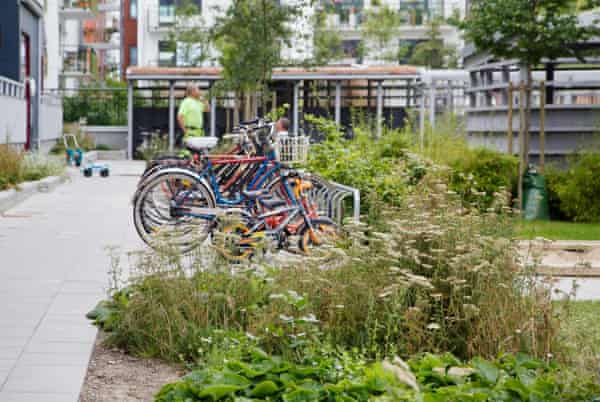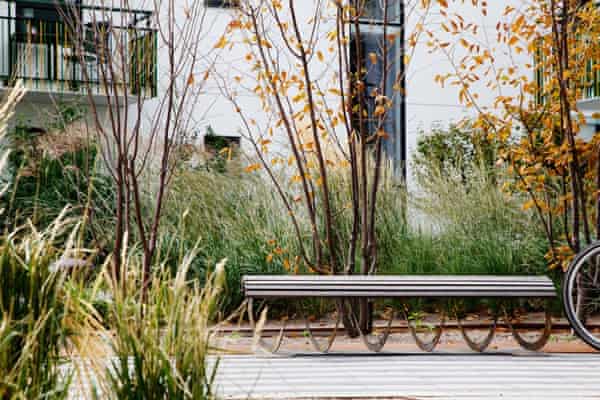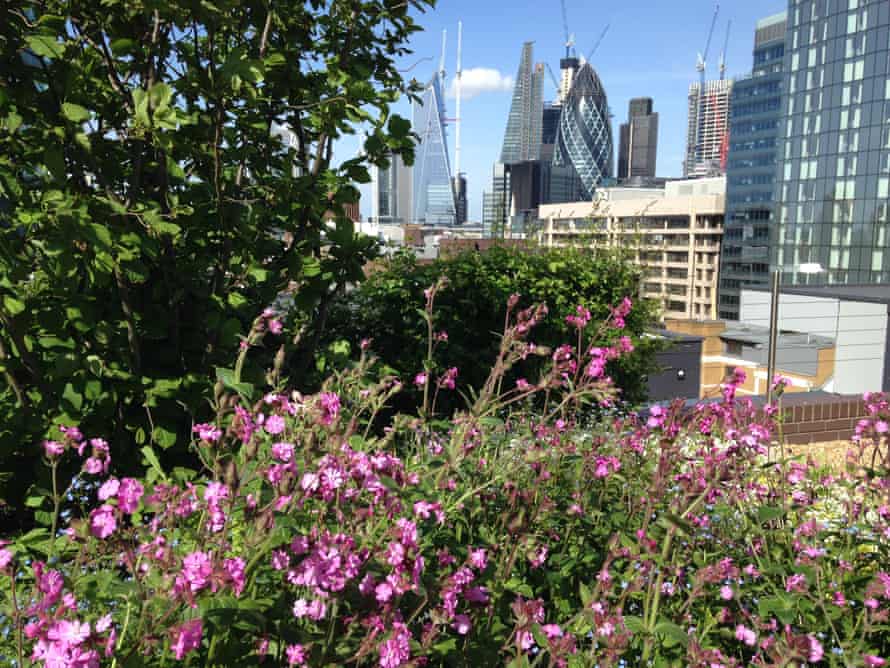If you want to see the best of what the city of Malmo’s “green points” system can achieve, head into a neighbourhood called Bo01, says landscape architect Anne Bronter. There, on the waterfront of the Western Harbour, you’ll find a cluster of housing blocks, each different from the next, but all centred on a nature-filled courtyard.
Sandwiched between parks, these courtyards, meeting spaces and pocket parks, are home to beds planted with a mix of native herbs and wildflowers, creeper plants and sustainable stormwater drains that double as wildlife ponds.
London will become the largest city in the world to introduce a green space system in the coming weeks as part of mayor Sadiq Khan’s London Plan, which was signed off by the housing secretary, Robert Jenrick, at the end of January. Called the Urban Greening Factor (UGF), the plan calls for boroughs to implement urban greening practices, with a handful – including Hackney and the City – already one step ahead. Much of the inspiration has come from the Swedish city.

At the turn of the millennium, the entire Western Harbour, a 20-minute walk from Malmo’s centre, was little more than 70 hectares (175 acres) of contaminated soil and deserted docklands, following the dramatic decline of the city’s shipbuilding industry. Bo01 (Bo means “live” in Swedish and 01 is short for 2001, the year the neighbourhood opened) was the first step in the area’s post-industrial regeneration, timed to coincide with the construction of the Oresund Bridge that linked Malmo to Copenhagen.
Built as a model community for a housing exposition, which heralded it as the “sustainable city of tomorrow”, Bo01 aimed to be the world’s first carbon neutral neighbourhood, powered by wind and heated by an underground geothermal hotspot.
From the outset, each of Bo01’s apartment blocks had to meet a green space factor (GSF), according to a city policy that demanded every development set aside a share of its footprint as green space and initially gave out biodiversity-focused bonus points for anything from tall fruiting trees and potted plants on the roadside, to tiny birdhouses and frog-filled ponds. What resulted were eclectic, characterful and distinct green social spaces, according to Bronter, who also works for Malmo’s planning department. “The courtyards are where you can see a difference in the use of the green space factor.”
“It was that, I think, that really grabbed me,” says Peter Massini, who visited in 2017. Massini led green infrastructure initiatives at the Greater London Authority (GLA) for 12 years, until December, and championed the framework to become part of London’s future.
“You walk around that part of Malmo and there are no parks with fences around them. Whereas the British model has been about physically protecting [green space], you get to Malmo and it’s got these green spaces and parks which are part of the public realm.”
First implemented in Berlin in 1994, the GSF framework is today one of the most widely adopted policy tools for urban greening, and has been implemented in Seattle, Hamburg, Southampton and Stockholm. Cities adapt the core GSF system to give different values to specific types of green space, for example, giving a higher value to ponds and areas for stormwater runoff in neighbourhoods with poor drainage. The formula allows city governments to integrate biodiversity-focused incentives for anything from animal habitats to native planting.
Q&AGreen space factor – how does it work?Show
The green space factor (GSF) – sometimes called an urban greening factor or green area factor – is a way of calculating green space requirements for new developments.
GSF measures typically give each square metre of tarmacked car park a score of zero and every square metre left as open meadow a value of one. Other spaces can earn higher or lower scores. In Malmo, a pond or stormwater system filled with water for more than half the year also scores one, a permeable gravel area with some plants has a value of 0.4, and paved areas designed to channel stormwater into sustainable drainage systems score 0.2.
These numbers are added up and divided by the total area of the development to give a score. Cities may demand that each development reaches a minimum target, typically 0.3.
But while Londoners might hope this new policy will spark a wave of creative rewilding, even Malmo’s supporters urge caution. A GSF system creates opportunities to realise the benefits of urban nature, rather than guaranteeing genuine change – with successes such as Bo01 also relying on a combination of complementary planning policies, participatory design processes, and ecological input.

When Malmo began building Bo01, a neighbourhood of about 1,400 homes in mostly four or five-storey housing blocks, its publicly-owned development company worked with landscape architects to ensure blocks met the required GSF score, bringing designers’ expertise to bear on oft-neglected courtyards and roadsides, says Bronter. The GSF only applied to these housing developments, with parks and public areas still set aside as part of an area masterplan.
GSF systems are best equipped to ensure a bottom line for green space in new developments and helped establish the leafy, alternative character of Bo01, says Tobias Emilsson, researcher in urban landscapes at the Swedish University of Agricultural Sciences. Advocates – such as the EU’s Green and Blue Space Adaptation for Urban Areas and Eco Towns (GRaBS) initiative – say that one of their most important attributes is that the core framework is easily adapted and tweaked for different cities. Malmo, for example, temporarily boosted the value of new ideas such as green roofs, which they encouraged local people to adopt. Once a novelty, “now, even your local contractor will know how to put [one] up”, says Emilsson.
Above all, however, it is a hands-off approach that allows each development’s designers and architects to be responsive to local needs, Massini says. “It is intended to encourage dialogue and collaboration between different stakeholders to come up with the best solution for the space. It was designed deliberately to be a little bit loose. My biggest fear, what I wanted to avoid doing, is it being prescriptive.”
In Malmo, though, initial successes flattered the system. As the Western Harbour development spread to Bo01 neighbour Flagghusen, the GSF system was simplified, and the system was “applied less stringently”, writes GRaBS report author Annika Kruuse, former project manager for the city of Malmo. This sought to reduce the high cost of development in Bo01 – which led to an affluent, mostly white population unrepresentative of Malmo’s diverse demographics – and to build more affordable housing.

Landscape designers continue to be involved in evolving projects, but without the in-depth participation seen in Bo01, says Bronter. And gone are the bonus points for bat boxes and hedgehog homes.
Crucially, two decades on, it is difficult to show the long-term biodiversity benefits from GSF in Bo01. Anecdotal evidence and one 2002 study showed an uplift in natural diversity, a year after construction, but studies by graduate students in Emilsson’s department found some green spaces were later covered over.
Perhaps the biggest lesson to be learned for London, is that private developers soon found shortcuts. “I think it was really clear in Bo01 that the developers quite quickly caught the idea of what is the cheapest solution to get the maximum factor,” says Emilsson. “Sedum roofs were rated really high so there’s a lot of sedum roofs,” with repetition limiting the benefits to wildlife.
Other developments were overcrowded with trees, says Bronter. “They got a high, high score, but in the long-term perspective, perhaps it would have been better with fewer trees.
“The positive side is that it’s very easy to understand,” she says. “It’s easy for politicians to have high ambitions in [saying] we want to have a high green area factor. But they don’t really understand that you can’t just say ‘We want to have a high number’ because it all depends on the site.

“There’s an obvious risk that it becomes a bit of a green-washing tool. But I think the danger is that everyone involved believes that using the GSF makes everything long-term greener. And I’m not sure it does; we don’t know if it does.”
Stockholm has taken lessons from Malmo, and created a more complex GSF system that scores developments separately for biodiversity, climate adaptation (including water management), and social and aesthetic factors.
Massini is under no illusions about the limits of London’s green area framework. Having departed the GLA at the end of 2020, he is happy to be leaving with not only the UGF set for the London Plan, but a suite of urban greening policies. These include two key rights to access of open green space and the requirement that developments contribute to a biodiversity net gain.
He argues the UGF should be seen as a “supplementary policy” that will allow developments to add to London’s traditional greenery. The type of questions UGF asks include: “What is the specific detailing you do on that development that provides a stepping stone for wildlife? Can you create some wetland features so it allows dragonflies from Walthamstow Marshes to forage more widely in the urban environment? Or does it provide a corridor of trees which allows bats to go from the Regent’s Canal to a nearby park, adding in those little links that just give wildlife a chance to thrive beyond the boundaries of the protected areas.”
In terms of promoting wilding, Massini sees the most potential for the UGF not in the mega-developments, such as the Olympic Park, but in creating incremental gains around the edge of parks, or between green spaces, or in dense neighbourhoods like Tower Hamlets or Elephant and Castle, where biodiversity has been near zero for decades, perhaps centuries.
GSF can operate in the places where there’s no traditional conservation effort, says Mathew Frith, director of conservation at London Wildlife Trust. While we’ll still need to protect the chalk grasslands in the south of the city, our rare remaining peat bogs and ancient woodland, there is plenty of space for more informal biodiversity, he says.

“Cities are always going to be melting pots of people and nature,” says Frith. “We have something like 15,000 species recorded in London, and a great proportion of those species come from other parts of the world through trade, gardening, food, textiles, etc. And so we’ve got this kind of cosmopolitan nature. And so, we can’t get too precious about some of those designs that are made.”
Landscape architect Klaus Overmeyer, from Berlin, the home of GSF, says the city’s policy was a fringe issue when adopted in the 1990s, when green space and disused corners of the city were abundant, but has become more key as Berlin’s land values have rocketed. Yet, he says, policy has mattered less than local people’s participation in the creation of the city’s unexpected green spaces.
Both Berlin and Malmo can teach London that recording values for greenery, “as if in a spreadsheet” is only useful if someone at the councils can still scrutinise a planning application and make sense of what these numbers might mean for the flourishing of local life, says Frith. Today, among London’s cash-strapped local authorities, only half have an ecologist on staff, and most are not in planning departments.
“For all the benefits of these tools – and they are tools – they are not necessarily the final answer,” he says. “Having informed ecological expertise is still critical.”
Find more age of extinction coverage here, and follow biodiversity reporters Phoebe Weston and Patrick Greenfield on Twitter for all the latest news and features